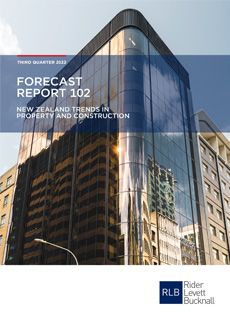According to the Rider Levett Bucknall (RLB) Forecast 102 report – New Zealand Trends in Property and Construction – the outlook for the property and construction sectors is very uncertain.
Prepared by the New Zealand Institute of Economic Research (Inc.) (NZIER) exclusively for Rider Levett Bucknall (RLB), Forecast 102 noted that higher cost pressures and interest rates are leading businesses to be more cautious about investment.
RLB Director, Grant Watkins said, “Nonetheless, with immigration and international border restrictions easing, RLB expects population growth from a gradual recovery in net migration inflows from next year will support underlying demand for non-residential and infrastructure construction demand over the longer term.”
According to Forecast 102, there was further growth in construction in the March 2022 quarter, thus continuing the recovery in activity since lockdown restrictions were relaxed in December 2021. While demand was strong, there remained challenges for the construction sector as COVID-19 infections accelerated over the first half of the year.
Labour shortages main constraint for building firms
Building sector firms grappled with staff shortages as workers stayed home either as a result of infection or self-isolation. This setback exacerbated the shortages from the difficulties firms faced in hiring workers given international border restrictions. Over 60 percent of building construction firms surveyed in the June 2022 NZIER Quarterly Survey of Business Opinion (QSBO) reported finding labour as the primary constraint on their business.
Against these supply-side challenges, demand for construction has been solid. Dwelling consent issuance points to a continued solid pipeline of residential construction work over the coming year. Residential construction demand in Auckland has been particularly strong, with annual dwelling consents issued in the region totalling over 21,500 for the year to June 2022.
There was also growth in dwelling consent issuance in other regions, including Wellington and Canterbury. While there looks to have been a flattening out in dwelling consent issuance in more recent months, the high level of issuance should support strong residential construction activity for the coming year.
Increased population density to drive housing intensification
Grant continued, “Growth in residential construction demand has been driven by the continued intensification of housing, with a continued surge in consent issuance for medium-density housing such as townhouses and flats. In contrast, demand for the construction of standalone houses has declined in recent months, although it still remains the most popular type of residential construction. We expect increased population density to continue driving housing intensification over the coming years.”
RLB expects increased government spending will support infrastructure construction growth over the coming years. The New Zealand Infrastructure Commission estimates the National Infrastructure Pipeline has increased to $72.9 billion in June – an increase of 5 per cent from the March quarter. Transport projects worth $30.3 billion dominated the pipeline and are expected to account for 34 per cent of the forecast infrastructure spend in 2022. For the 2022 year, social sector projects for social housing, education, community facilities and health infrastructure are expected to make up almost half of the infrastructure spending.
Higher costs and interest rates adding uncertainty to short-term outlook
The outlook for the construction sector is mixed, with higher costs and interest rates adding uncertainty to the near-term outlook. For residential construction, beyond the solid pipeline for the coming year, there are signs of softening demand. Builders report a drop in enquiries, suggesting an easing in residential construction later in 2023. Higher interest rates and tighter access to finance are expected to weigh on construction demand, particularly in the residential sector.
According to Forecast 102, The NZIER QSBO highlights the intense cost pressures in the construction sector. A net 85 per cent of construction firms reported increased costs in the June quarter. While this was an easing from the 91 per cent reporting higher costs in the previous quarter, it is still at historically high levels. As discussed, capacity constraints stemming from acute labour shortages and the impact of supply chain disruptions on the availability of building materials are driving up costs.
Construction cost increases moderating in coming months
Despite the large proportion of construction firms facing intense cost pressures, firms do not look to be passing these higher costs on as readily. Only a net 45 per cent of construction firms increased prices in the June quarter, suggesting a squeezing of operating margins in the construction sector. Pricing intentions for the next quarter are even softer, with a net 31 per cent of construction firms expecting to raise prices.
This contrasts with the 89 per cent of construction firms expecting costs to increase in the next quarter. These survey results potentially provide early signs of a moderation in construction cost increases in the coming months.
Annual non-residential construction cost inflation at record high
Grant said, “Non-residential construction cost inflation continued to pick up in the June 2022 quarter. The 3.6 per cent increase in non-residential construction costs over the quarter brought annual non-residential construction cost inflation to 10.9 per cent for the year to June 2022 – a new record high.”
“We expect a moderation in the quarterly increase in non-residential construction costs, but that on an annual basis, it will remain at its current peak for the September quarter. Beyond that, we expect an easing in capacity constraints in the construction sector will drive an easing in construction cost inflation,” he added.
Shipping and global supply chain disruptions lessening
Grant concluded, “We expect the relaxation of immigration and border restrictions will help to alleviate labour shortages, while there are signs shipping and global supply chain disruptions are lessening. That said, these constraints will take some time to be resolved, and given the high inflation environment more broadly, we expect annual non-residential construction cost inflation to remain elevated at 5.4 per cent at the end of 2023.”
FURTHER INFORMATION:



